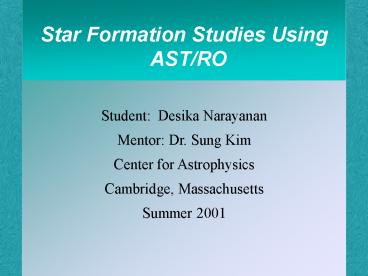Star Formation Studies Using AST/RO - PowerPoint PPT Presentation
1 / 23
Title:
Star Formation Studies Using AST/RO
Description:
Star Formation Studies Using AST/RO. Student: Desika Narayanan. Mentor: Dr. Sung Kim ... Observations were made in a series of pointings. ... – PowerPoint PPT presentation
Number of Views:30
Avg rating:3.0/5.0
Title: Star Formation Studies Using AST/RO
1
Star Formation Studies Using AST/RO
Student Desika Narayanan Mentor Dr. Sung
Kim Center for Astrophysics Cambridge,
Massachusetts Summer 2001
2
Objective
-Stars are born in the pockets of Giant
Molecular Clouds. - Photodissociation regions
(PDRs) are areas in the clouds where the Far
Ultraviolet light of newborn stars play an
integral role in the chemistry of molecular
clouds - Why study these PDRs? They regulate
star formation. -Objective of scientific study
to better understand the role of PDRs in GMCs.
3
Mapping
- Mapping Regions of Emission in
- CO (7--gt6) 809 GHz
- 12CI 809GHz
- CO (4--gt3) 460 GHz
- CO (2--gt1) 230 GhzClouds Studied
- Small Magallenic Cloud (East and West)
- Large Magallenic Cloud
- NGC 6334 (Galactic)Good mapping will hopefully
indicate where star formation might be going on.
Further inspection of the spectra taken at
different locations will help define physical
parameters such as temperature, density and
elemental abundance.
4
How do we study the PDRs?
5
Observations
- Observations were made in a series of pointings.
After data are reduced, and spectra obtained,
these locations are used to make a contour map of
emission. - All observations were made with the Antarctic
Submillimeter Telescope and Remote Observatory
(AST/RO) - Has the ability to observe 230, 460, 490, 806 and
809 Ghz windows - Utilizes the high and dry atmosphere of the
pole's environment to improve quality of data
IRAS 100 micron image
P
Pointings in SMC-E
6
Spectra Temperature versus Frequency
7
Baseline Ripple
- Baseline ripples caused by -Rapid changes in
atmosphere -Gain instabilities in
mixer -Impedance mismatch in instrumentation
(causes standing waves) - Removed by polynomial fit and subtraction in Comb
- Removed by Fourier transform algorithm
- Problems with polynomial fitting -Want to fit
around line to avoid removing signal (line not
always clear) -Best to subtract over whole line
rather than pieces to avoid rms problems down the
road (difficult then to get a good fit) -High
order fitting can introduce artificial features
8
Before Linear Baseline Subtraction
9
Subtraction around the line
10
Fourier Transforms
- Used for a more serious form of sinusoidal
ripple - F(s) ?f(x)e-i2xspdx-Picks out sinusoidal
functions with certain amplitudes and phases. - Comb plots F(s) versus frequency and allows you
to remove certain components
11
Messy spectra with obvious emission lines
- Possible line at -40 km/s?
12
Fourier Transform
- The ripple is the spike off the chart. If we
remove bright components,we can get rid of some
of ripple.
13
4 components were removed, after the first 5
- Note the recovery of the third line
14
SMC Observations
- Observations divided intoSMC-E and SMC-W
- Each observation made in a seriesof pointings
1.7' apart (distance varies for different obs.
Runs). - SMC-E and SMC-W both studied at 230 Ghz (CO
J2--gt1)
SMC-B
15
SMC Results
- SMC-E had too low of a S/N to get any lines out.
More observation time is needed. SMC-W had bad
baseline problems that I couldn't get outSMC-W
Raw Data
16
SMC-W emission
- Many of the pointings ended up showing nice
emission
17
SMC-W map
18
NGC 6334 (460GHz)
- Measured at-460 GHz (CO J4--gt3)-809 GHz (CO
J7--gt6)-809 GHz (12CI) - Raw data was Excellent
- Reductions only involved linear baseline
subtraction
19
460 Ghz (CO J4--gt3)
20
CO 809 Ghz (J7--gt6)
- The higher transitions map traces the hotter and
denser regions of the molecular cloud
21
12 CI (809 GHz)
- .
22
Conclusions
Personal - I Learned about mathematical data
reduction processes (ie Fourier transform,
baseline fitting) - I was able to learn some of
the science behind studying Star Forming regions
- Mapping Techniques - Sampling
Theorem Scientific - The CO emission and 12CI
emission occurs in relatively similar areas in
NGC 6334
23
Ackowledgements
-Dr. Sung Kim -AST/RO Group -CARA































